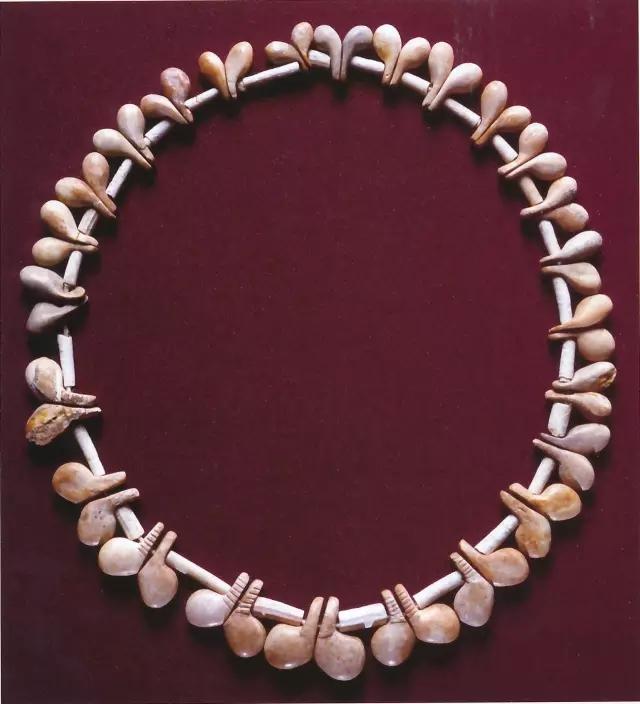- The origin of jewelry
In the course of thousands of years of history, the use of jewelry is not static. Initially, to obtain prey, humans often draped animal skins on their bodies, put horns on their heads, dressed as the same kind of prey to confusing each other. There are also ancestors for the need to remember, in the neck to wear small gravel or small animal bones and animal teeth. With the progress of mankind and cultural transmutation, the value of jewelry has undergone a series of functional transformations such as political stature, moral endowment, economic value, ceremonial function, and religious instrument. Nowadays, the most widespread use of jewelry is decoration and playfulness.
- the meaning of jewelry to wear
1. Wear jewelry to ward off evil and seek peace
Nature in the wind and rain, lightning, human reproduction in the old, sick and dead, are normal natural phenomena. But in the ancient view, these are the heavens and the gods and ghosts in the manipulation. To avoid disasters and seek the peace of existence, people often resorted to witchcraft rituals to pray for the protection of the gods. Thus, at some specific times, men, women, and children danced around the fire or held rituals, and hung some things on their ankles and wrists that would make loud noises, and with the movements of the dance, these noises were very melodious and also met the psychological needs of people to ward off evil spirits. These pendants are considered to be the origin of jewelry.
2. Wearing jewelry is a kind of totem worship
The word „totem“ is the translation of the North American Indian Algonquin tribe Ojibwa dialect „totem“. What is a totem? In the book „Totem Culture and the Origin of Human Cultures“, it is written that:
(1) a totem is a sign or symbol of a clan;
(2) a totem is a living or non-living creature related to the group by blood;
(3) a totem is a living or non-living creature as an ancestor;
(4) a totem is an object as a protective deity;
(5) a totem is an object as a relative or ancestor;
(6) a totem is a living or non-living creature as a clan ancestor and guardian;
(7) a totem is a creature as a clan ancestor and guardian. Totem was initially used as a symbol of the clan, but later evolved into some kind of object for the destruction of the clan;
(8) A totem is a living or non-living thing as an ancestor or a person with some special relationship.
Totem decoration is an artistic means in totemic activities. People want the totem to protect themselves at all times, they assimilate themselves to the totem. For example, they wore the fur or other parts of the totem animal, or braided and knotted their hair and decorated their bodies. Grose says, „Primitive decoration, half fixed, half movable.“ Fixed decorations include tattoos, knotted hair, pierced nose, lip, chiseled teeth, etc. For example, in some clans in Australia, most pierced through the nose, and then inserted bone pieces, etc., the purpose is not for beauty, but as a sign, praying for the protection of the totem. Some African indigenous clans and North American Indians have the custom of inlaid lips, to make the shape of the lips similar to the totem animal, a totem belief. Unfixed decorations mainly refer to clothing and wearing accessories. For example, members of the Wolf Clan are clothed in full wolf skins. Some Australian clan members dress up in totemic postures with colored earth, feathers, leaves, and other materials during ceremonies. In the Bai tribe near the Erhai Sea in Yunnan Province, fish were used as totems in ancient times, so „fishtail“ headgear is prevalent, while some use tiger heads, tiger skins, or dog or chicken crowns as ornaments. In the totem activities, dance is often an important artistic content, clan members dressed in totem costumes, or make-up dance in totem mode.
Totem worship and totem activities were the main uses of ancient jewelry. In modern jewelry, the jewelry shapes of various animals and plants are popular, which may have a potential connection with human totem worship. The dragon and phoenix patterns in traditional Chinese pendants and the dragon, snake, turtle, and insect patterns on the ring are such examples.
3. Jewelry is a symbol of wealth and status
Famous movie star Sophia Loren wrote in the book „Women and Beauty“ that on some important occasions, to show their identity, it is necessary to wear expensive jewelry; while in ordinary times, to be safe, often wear inexpensive clothing jewelry. In Africa, many tribal chiefs, to show off their status and wealth, often in the wife, daughter’s body hanging many pieces of jewelry, some even to the peak of the situation. For example, an African tribal leader called composing Mburi, his wives wear necklaces around their necks add up to 800 pounds.
In the past, Western society often has the number of jewelry and the degree of preciousness to measure a person’s status and identity. Matilde, the heroine of Maupassant’s novel „The Necklace“, is married to a minor section of the Ministry of Education, and when she and her husband Losel are invited to a grand party by the Minister of Education, the first thing she does after the excitement is to agonize over the lack of decent clothes and precious jewelry. Later, she goes to the party wearing a diamond necklace she borrowed from Mrs. Volleje, and the beautiful, charming Mathilde is enchanted. When the ball was over, Mathilde lost the necklace in her complacency. She suffers for 10 years to compensate for the necklace. The result is ridiculous, Mathilde lost only a worthless imitation diamond necklace. This story may reflect the importance of jewelry for a woman’s status and position from the side.
When people found beauty in jewelry, they gave it aesthetic value. The development of jewelry is accompanied by the development of productivity, from the original stone and bone decoration, bronze decoration to gold and silver jewelry decoration, to the development of a wide variety of jewelry now, all kinds of strange. This is not only the development of human aesthetic sensibility but also an important symbol of cultural and technological development.
4. The decorative meaning of jewelry
Grose in the book „the origin of art“ wrote: „like to decorate, is the earliest and strongest human desire.“ People decorate for beauty, using various materials and means to decorate and embellish the parts of the body that show the most beautiful. In addition to the three main subjects of hair, makeup and clothing, wearing all kinds of accessories is the most enthusiastic thing people do. Each nationality has its own traditional ornaments and decoration methods. The style of decoration varies from time to time.
For the aesthetics of jewelry, different times background, cultural backgrounds, and regional backgrounds will produce different aesthetic standards and aesthetic interests. For example, the Tang Dynasty pursued splendor and complexity, the Ming and Qing dynasties advocated nature and freshness, Westerners pursued aesthetic individuality, Easterners were inclined to subtle beauty, and some African nations were keen on strong and rich decorative style.
In addition to the cultural background of the times, the popularity and changes of clothing, new developments in jewelry materials, and production techniques also affect people’s aesthetics to a great extent. Modern people’s aesthetics is multi-layered and full of changes. The decorative style of jewelry, due to the shortening of the popular cycle of clothing and constantly to the direction of new and different development.
5. Wearing jewelry is the trust of faith
Although gemstones are only mineral crystals, they are always associated with good luck, happiness, and other beautiful meanings in people’s minds. For example, jade is believed to be able to eliminate disasters and refuge, turquoise has the meaning of „all things will go well“, amber can calm evil and safe, a diamond means faithfulness and purity, ruby is a symbol of love, pearl can bless people with health and longevity.
In recent years, the constellations and birthstones believed in by Westerners have been gradually accepted by young people in China with the exchange of Eastern and Western cultures. The so-called horoscope refers to the position of the zodiac. According to the theory of astrology, the position of the zodiac signs on the horizon at the time of a person’s birth is related to the fate of the person born. This has similarities with the Chinese doctrine of destiny regarding the birth signs. It is according to this psychology of people’s spiritual attachment that jewelers market their goods while giving them a beautiful symbolic meaning.
It is said that the wearing of birthstones is recorded in the „Old Testament Book of Exodus“ and „New Testament Book of Revelation“. The twelve saints in the book, the twelve stones in front of the breastplate, the twelve angels of the kingdom of heaven, and the twelve months of the year can all correspond to each other.
When people buy gemstone jewelry, in addition to factors such as decoration and value, they also use the symbolic meaning of the gemstone as a reference point for purchasing. The psychological comfort and balance, the spiritual enjoyment and sublimation that jewelry brings to people are incomparable to other material things.




Leave A Comment